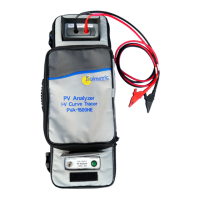Measuring Irradiance, Temperature, and Tilt
6-102
Entering Irradiance Manually
When this option is selected, the user manually enters an irradiance value obtained by another method
such as a hand-held sensor or an array mounted reference cell. This option has several disadvantages:
• It is often difficult to accurately orient hand-held irradiance sensors in the plane of the array.
• A greater and more variable time delay between the I-V curve and irradiance measurements
translates into irradiance error under conditions of rapidly changing irradiance.
• Hand-held irradiance sensors may have poor accuracy, especially in their cosine response. This
introduces very significant irradiance error when the sun is off axis of the array and under
diffuse light conditions.
Measuring PV Module Backside Temperature with a
Thermocouple
Measurement of backside temperature is one of the traditional methods used by I-V curve tracers. It has
several benefits and limitations.
The Backside Thermocouple method provides these benefits:
• It is a direct method with no dependence on a PV model.
• It enables you to choose the location for temperature measurement; it’s best to choose an
average temperature location and avoid locations that are much hotter or much closer to the
cooler edges of the array.
• The Backside Thermocouple method has these limitations:
• The predictive PV model wants to know the cell temperature, but the thermocouple measures
the slightly cooler backside temperature. The PVA software partially compensates for this by
adding up to 3-degrees Celsius to the measured backside temperature. The amount of
compensation varies in proportion to irradiance, since at high irradiance the difference between
cell and backside temperature is higher.
• Backside temperature varies substantially across a PV module, string, or array. This variation
is caused by patterns of convective cooling that depend on degree of ventilation, relative
location in the array, and exposure to wind. For this reason, your temperature measurements
can be biased higher or lower than actual.

